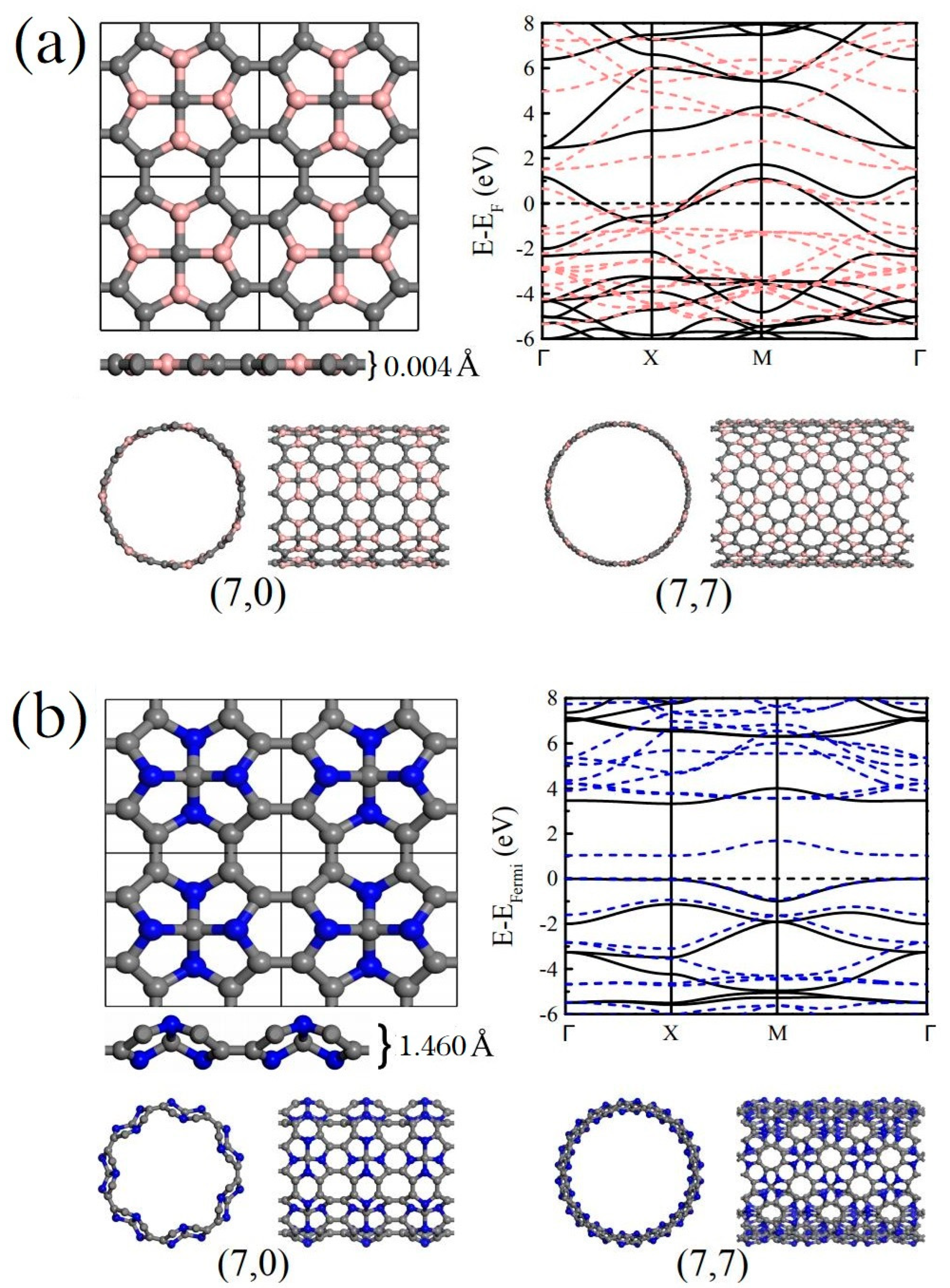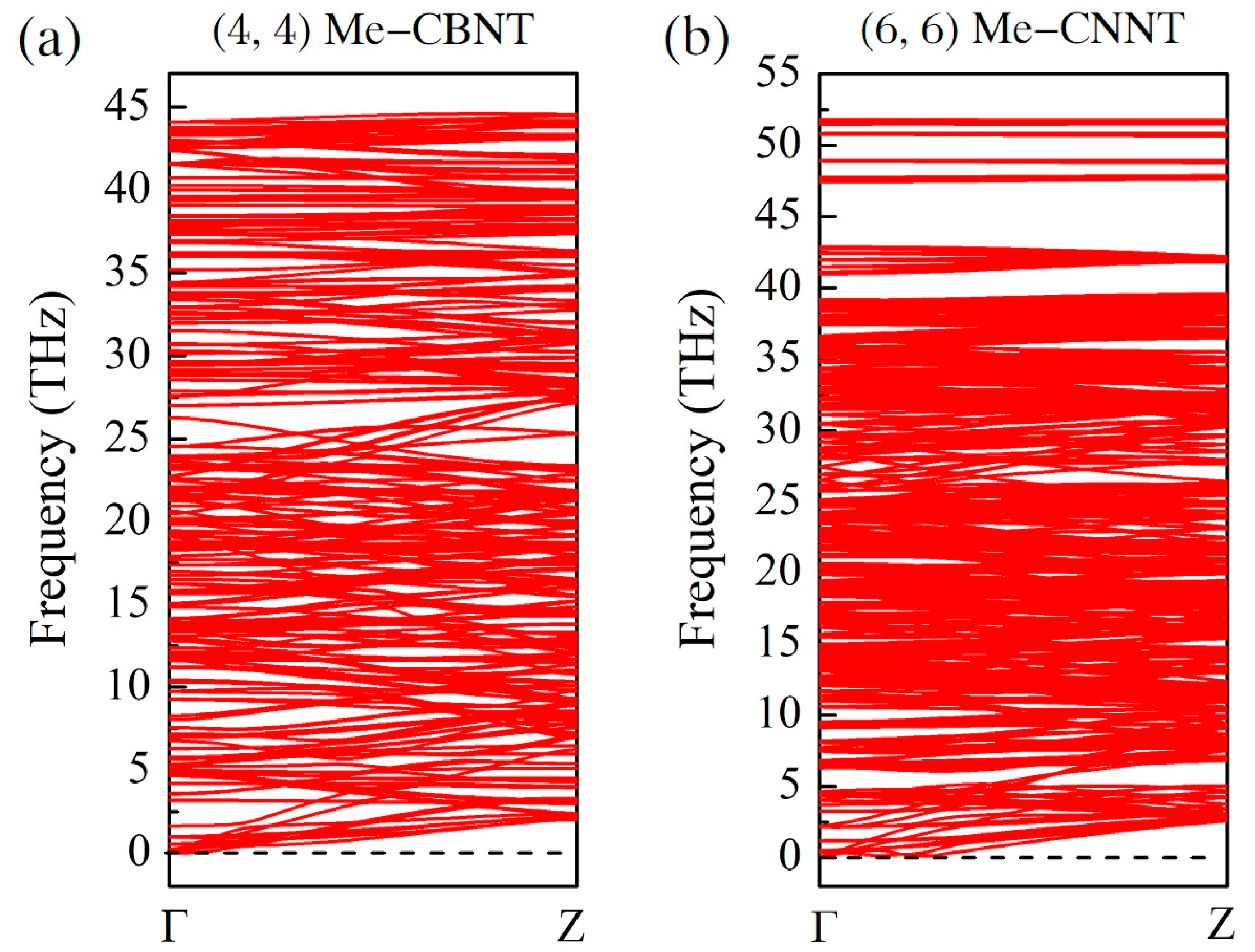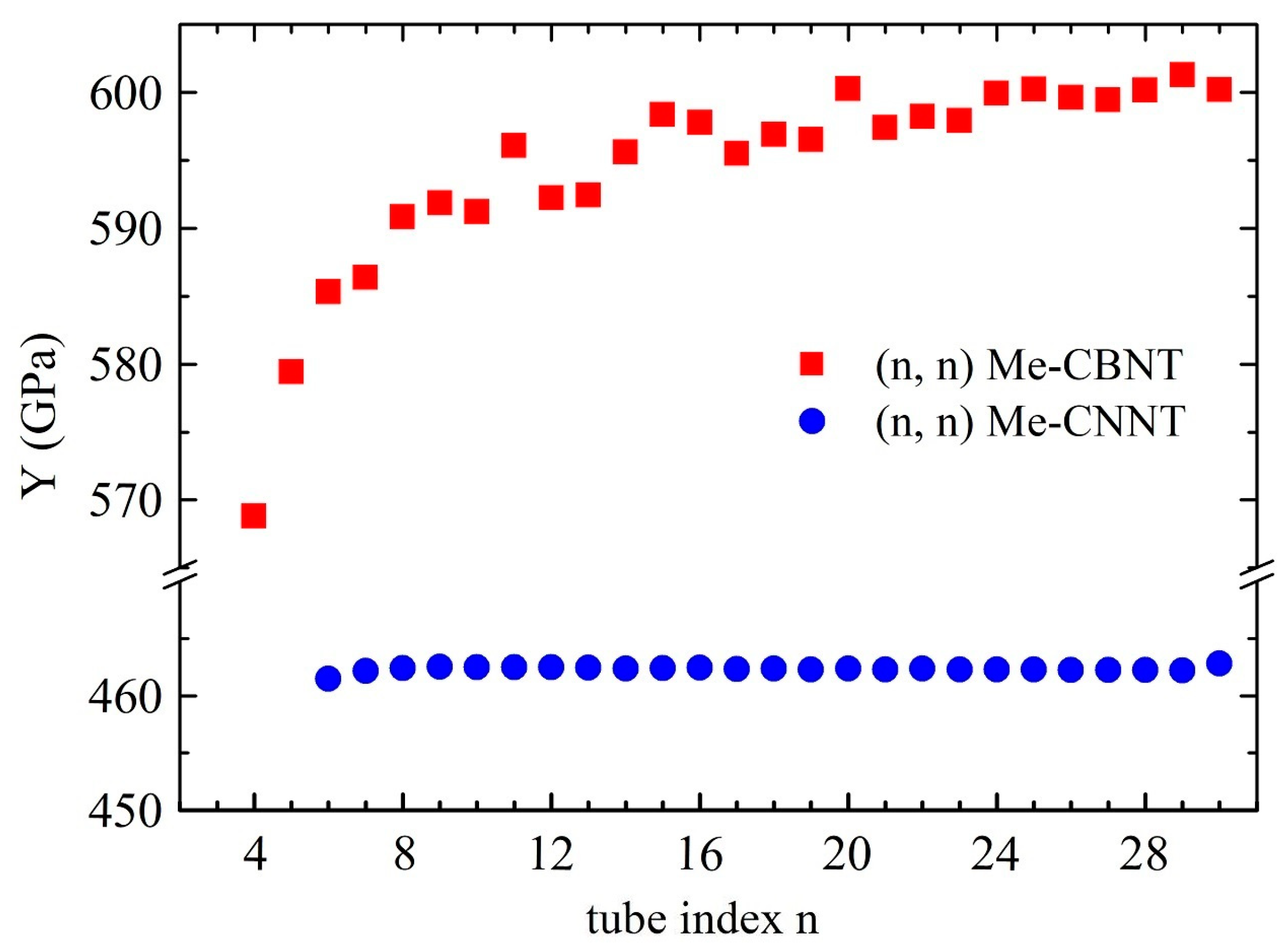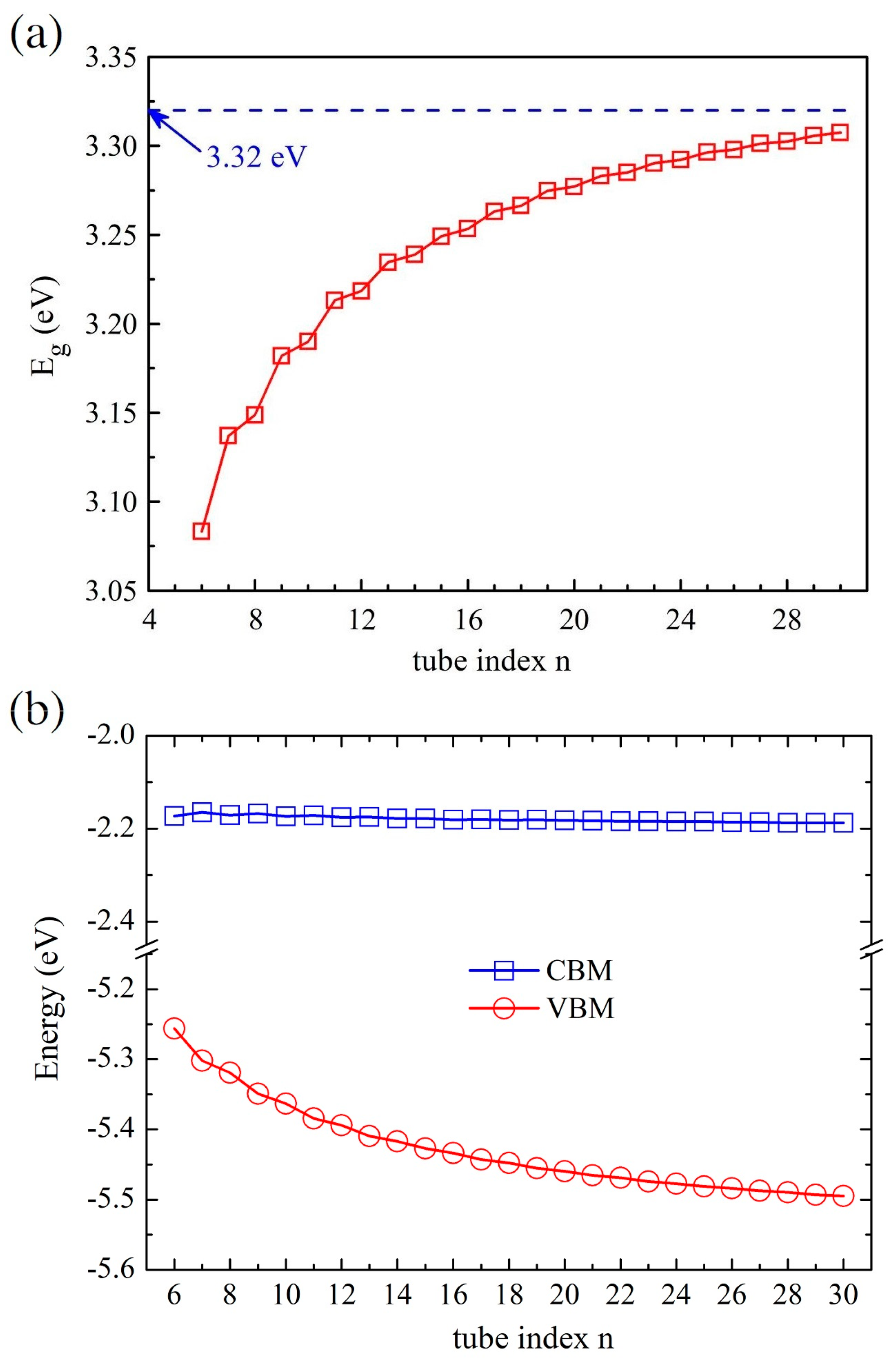Theoretical Study on (n,n)-Nanotubes Rolled-up from B/N Substituted Me-Graphene
Abstract
1. Introduction
2. Materials and Methods
3. Results
3.1. Geometric Configurations and Stabilities
3.2. Mechanical Properties
3.3. Electronic Properties
4. Conclusions
Supplementary Materials
Author Contributions
Funding
Institutional Review Board Statement
Informed Consent Statement
Data Availability Statement
Conflicts of Interest
References
- Mortazavi, B.; Shahrokhi, M.; Rabczuk, T.; Pereira, L.F.C. Electronic, optical and thermal properties of highly stretchable 2D carbon Ene-yne graphyne. Carbon 2017, 123, 344–353. [Google Scholar] [CrossRef]
- Jia, Z.; Zuo, Z.; Yi, Y.; Liu, H.; Li, D.; Li, Y.; Li, Y. Low temperature, atmospheric pressure for synthesis of a new carbon Ene-yne and application in Li storage. Nano Energy 2017, 33, 343–349. [Google Scholar] [CrossRef]
- Li, Q.; Li, Y.; Chen, Y.; Wu, L.; Yang, C.; Cui, X. Synthesis of γ-graphyne by mechanochemistry and its electronic structure. Carbon 2018, 136, 248–254. [Google Scholar] [CrossRef]
- Li, Q.; Yang, C.; Wu, L.; Wang, H.; Cui, X. Converting benzene into γ-graphyne and its enhanced electrochemical oxygen evolution performance. J. Mater. Chem. A 2019, 7, 5981–5990. [Google Scholar] [CrossRef]
- Hu, Y.; Wu, C.; Pan, Q.; Jin, Y.; Lyu, R.; Martinez, V.; Huang, S.; Wu, J.; Wayment, L.J.; Clark, N.A.; et al. Synthesis of γ-graphyne using dynamic covalent chemistry. Nat. Synth. 2022, 1, 449–454. [Google Scholar] [CrossRef]
- Li, Y.; Xu, L.; Liu, H.; Li, Y. Graphdiyne and graphyne: From theoretical predictions to practical construction. Chem. Soc. Rev. 2014, 43, 2572–2586. [Google Scholar] [CrossRef]
- Gao, X.; Liu, H.; Wang, D.; Zhang, J. Graphdiyne: Synthesis, properties, and applications. Chem. Soc. Rev. 2019, 48, 908–936. [Google Scholar] [CrossRef]
- Fan, Q.; Yan, L.; Tripp, M.W.; Krejčí, O.; Dimosthenous, S.; Kachel, S.R.; Chen, M.; Foster, A.S.; Koert, U.; Liljeroth, P.; et al. Biphenylene network: A nonbenzenoid carbon allotrope. Science 2021, 372, 852–856. [Google Scholar] [CrossRef]
- Puigdollers, A.R.; Alonso, G.; Gamallo, P. First-principles study of structural, elastic and electronic properties of α-, β- and γ-graphyne. Carbon 2016, 96, 879–887. [Google Scholar] [CrossRef]
- Malko, D.; Neiss, C.; Vines, F.; Görling, A. Competition for Graphene: Graphynes with Direction-Dependent Dirac Cones. Phys. Rev. Lett. 2012, 108, 086804. [Google Scholar] [CrossRef]
- Zhang, S.; Zhou, J.; Wang, Q.; Chen, X.; Kawazoe, Y.; Jena, P. Penta-graphene: A new carbon allotrope. Proc. Natl. Acad. Sci. USA 2015, 112, 2372–2377. [Google Scholar] [CrossRef] [PubMed]
- Sharma, B.R.; Manjanath, A.; Singh, A.K. Pentahexoctite: A new two-dimensional allotrope of carbon. Sci. Rep. 2014, 4, 7164. [Google Scholar] [CrossRef] [PubMed]
- Liu, Y.; Wang, G.; Huang, Q.; Guo, L.; Chen, X. Structural and Electronic Properties of T Graphene: A two-Dimensional carbon allotrope with tetrarings. Phys. Rev. Lett. 2012, 108, 225505. [Google Scholar] [CrossRef] [PubMed]
- Sheng, X.L.; Cui, H.J.; Ye, F.; Yan, Q.B.; Zheng, Q.R.; Su, G. Octagraphene as a versatile carbon atomic sheet for novel nanotubes, unconventional fullerenes, and hydrogen storage. J. Appl. Phys. 2012, 112, 074315. [Google Scholar] [CrossRef]
- Lu, J.P. Elastic Properties of Carbon Nanotubes and Nanorope. Phys. Rev. Lett. 1997, 79, 1297–1300. [Google Scholar] [CrossRef]
- Salvetat-Delmotte, J.P.; Rubio, A. Mechanical properties of carbon nanotubes: A fiber digest for beginners. Carbon 2002, 40, 1729–1734. [Google Scholar] [CrossRef]
- Lee, C.; Wei, X.; Kysar, J.W.; Hone, J. Measurement of the Elastic Properties and Intrinsic Strength of Monolayer Graphene. Science 2008, 321, 385–388. [Google Scholar] [CrossRef]
- Yang, D.C.; Jia, R.; Wang, Y.; Kong, C.P.; Wang, J.; Ma, Y.; Eglitis, R.I.; Zhang, H.X. Novel Carbon Nanotubes Rolled from 6,6,12-Graphyne: Double Dirac Points in 1D Material. J. Phys. Chem. C 2017, 121, 14835–14844. [Google Scholar] [CrossRef]
- Faria, B.; Silvestre, N.; Lopes, J.N. Strength and fracture of graphyne and graphdiyne nanotubes. Comp. Mater. Sci. 2020, 171, 109233. [Google Scholar] [CrossRef]
- Coluci, V.R.; Braga, S.F.; Legoas, S.B.; Galvão, D.S.; Baughman, R.H. Families of carbon nanotubes: Graphyne-based nanotubes. Phys. Rev. B 2003, 68, 035430. [Google Scholar] [CrossRef]
- Coluci, V.R.; Braga, S.F.; Legoas, S.B.; Galvão, D.S.; Baughman, R.H. New families of carbon nanotubes based on graphyne motifs. Nanotechnology 2004, 15, 142–149. [Google Scholar] [CrossRef]
- Zhao, H.; Wei, D.; Zhou, L.; Shi, H.; Zhou, X. Thermal conductivities of graphyne nanotubes from atomistic simulations. Comp. Mater. Sci. 2015, 106, 69–75. [Google Scholar] [CrossRef]
- Kang, B.; Lee, J.Y. Electronic properties of α-graphyne nanotubes. Carbon 2015, 84, 246–253. [Google Scholar] [CrossRef]
- Li, G.; Li, Y.; Qian, X.; Liu, H.; Lin, H.; Chen, N.; Li, Y. Construction of tubular molecule aggregations of graphdiyne for highly efficient field emission. J. Phys. Chem. C 2011, 115, 2611–2615. [Google Scholar] [CrossRef]
- Wang, Y.; Chen, N.; Liu, Y.; Zhou, X.; Pu, B.; Qing, Y.; Zhang, M.; Jiang, X.; Huang, J.; Tang, Q.; et al. MXene/Graphdiyne nanotube composite films for Free-Standing and flexible Solid-State supercapacitor. Chem. Eng. J. 2022, 450, 138398. [Google Scholar] [CrossRef]
- Chopra, N.G.; Luyken, R.J.; Cherrey, K.; Crespi, V.H.; Cohen, M.L.; Louie, S.G.; Zettl, A. Boron Nitride Nanotubes. Science 1995, 269, 966–967. [Google Scholar] [CrossRef]
- Golberg, D.; Bando, Y.; Tang, C.C.; Zhi, C.Y. Boron Nitride Nanotubes. Adv. Mater. 2007, 19, 2413–2432. [Google Scholar] [CrossRef]
- Wang, J.; Lee, C.H.; Yap, Y.K. Recent advancements in boron nitride nanotubes. Nanoscale 2010, 2, 2028–2034. [Google Scholar] [CrossRef]
- Allam, N.K.; Shankar, K.; Grimes, C.A. A General Method for the Anodic Formation of Crystalline Metal Oxide Nanotube Arrays without the Use of Thermal Annealing. Adv. Mater. 2008, 20, 3942–3946. [Google Scholar] [CrossRef]
- Chen, X.; Unruh, K.M.; Ni, C.; Ali, B.; Sun, Z.; Lu, Q.; Deitzel, J.; Xiao, J.Q. Fabrication, Formation Mechanism, and Magnetic Properties of Metal Oxide Nanotubes via Electrospinning and Thermal Treatment. J. Phys. Chem. C 2011, 115, 373–378. [Google Scholar] [CrossRef]
- Li, H.; Chen, S.; Zhang, Y.; Zhang, Q.; Jia, X.; Zhang, Q.; Gu, L.; Sun, X.; Song, L.; Wang, X. Fabrication, Systematic design of superaerophobic nanotube-array electrode comprised of transition-metal sulfides for overall water splitting. Nat. Commun. 2018, 9, 2452. [Google Scholar] [CrossRef] [PubMed]
- Yu, X.Y.; Yu, L.; Lou, X.W. Metal Sulfide Hollow Nanostructures for Electrochemical Energy Storage. Adv. Energy Mater. 2016, 6, 1501333. [Google Scholar] [CrossRef]
- Hahn, R.; Schmidt-Stein, F.; Salonen, J.; Thiemann, S.; Song, Y.; Kunze, J.; Lehto, V.-P.; Schmuki, P. Semimetallic TiO2 Nanotubes. Angew. Chem. Int. Ed. 2009, 48, 7236–7239. [Google Scholar] [CrossRef]
- Roy, P.; Berger, S.; Schmuki, P. TiO2 Nanotubes: Synthesis and Applications. Angew. Chem. Int. Ed. 2011, 50, 2904–2939. [Google Scholar] [CrossRef]
- Ge, M.; Li, Q.; Cao, C.; Huang, J.; Li, S.; Zhang, S.; Chen, Z.; Zhang, K.; Al-Deyab, S.S.; Lai, Y. One-dimensional TiO2 Nanotube Photocatalysts for Solar Water Splitting. Adv. Sci. 2017, 4, 16001. [Google Scholar]
- Zhuo, Z.; Wu, X.; Yang, J. Me-graphene: A graphene allotrope with near zero Poisson’s ratio, sizeable band gap, and high carrier mobility. Nanoscale 2020, 12, 19359–19366. [Google Scholar] [CrossRef]
- Ram, B.; Mizuseki, H. C568: A new two-dimensional sp2-sp3 hybridized allotrope of carbon. Carbon 2020, 158, 827–835. [Google Scholar] [CrossRef]
- Gao, Q.; Sahin, H.; Kang, J. Strain tunable band structure of a new 2D carbon allotrope C568. J. Semicond. 2020, 41, 082005. [Google Scholar] [CrossRef]
- Marinho, E.; da Silva Autreto, P.A. Me-graphane: Tailoring the structural and electronic properties of Me-graphene via hydrogenation. Phys. Chem. Chem. Phys. 2021, 23, 9483–9491. [Google Scholar] [CrossRef]
- Yang, Y.; Zhang, G.; Zhu, Y.; Peng, X.; He, L. Electronic properties of hydrogen/fluorine adsorbed two-dimensional C568: A first-principles study. Surf. Interfaces 2022, 31, 102067. [Google Scholar] [CrossRef]
- Sampaio-Silva, A.; Ferreira, D.F.; Silva, C.A.B., Jr.; Del Nero, J. Hydrogenation, width and strain effect in Me-graphene devices. Comp. Mater. Sci. 2022, 210, 111456. [Google Scholar] [CrossRef]
- Zhao, W.H.; Li, F.Y.; Zhang, H.X.; Eglitis, R.I.; Wang, J.; Jia, R. Dopingat at sp3-site in Me-graphene(C568) for new anodes in rechargeable Li-ion battery. Appl. Surf. Sci. 2023, 607, 154895. [Google Scholar] [CrossRef]
- Zhao, W.H.; Zhang, J.Q.; Zhang, H.X.; Wang, J.; Jia, R. 2D Boron Carbide, Carbon Nitride, and Silicon Carbide: A Theoretical Prediction. ACS Appl. Electron. Mater. 2022, 4, 4903–4911. [Google Scholar] [CrossRef]
- Dovesi, R.; Erba, A.; Orlando, R.; Zicovich-Wilson, C.M.; Civalleri, B.; Maschio, L.; Rérat, M.; Casassa, S.; Baima, J.; Salustro, S.; et al. Quantum-Mechanical Condensed Matter Simulations with CRYSTAL. WIREs Comput. Mol. Sci. 2018, 8, e1360. [Google Scholar] [CrossRef]
- Perdew, J.P.; Burke, K.; Ernzerhof, M. Generalized Gradient Approximation Made Simple. Phys. Rev. Lett. 1996, 77, 3865–3868. [Google Scholar] [CrossRef] [PubMed]
- Laun, J.; Vilela Oliveira, D.; Bredow, T. Consistent gaussian basis sets of double- and triple-zeta valence with polarization quality of the fifth period for solid-state calculations. J. Comput. Chem. 2018, 39, 1285–1290. [Google Scholar] [CrossRef]
- Becke, A.D. Density-functional thermochemistry. III The role of exact exchange. J. Chem. Phys. 1993, 98, 5648. [Google Scholar] [CrossRef]
- Li, M.; Reimers, J.R.; Ford, M.J.; Kobayashi, R.; Amos, R.D. Accurate prediction of the properties of materials using the CAM-B3LYP density functional. J. Comput. Chem. 2021, 42, 1486–1497. [Google Scholar] [CrossRef]
- Allec, S.I.; Wong, B.M. Inconsistencies in the Electronic Properties of Phosphorene Nanotubes: New Insights from Large-Scale DFT Calculations. J. Phys. Chem. Lett. 2016, 7, 4340–4345. [Google Scholar] [CrossRef]
- Yi, Z.J.; Wu, M.; Pang, Y.; Jia, R.; Xu, R.R. Non-local dielectric screening effects in phosphorene/g-C3N4 heterojunctions. Appl. Surf. Sci. 2021, 567, 150842. [Google Scholar] [CrossRef]
- Yi, Z.; Wu, M.; Jia, R. Edge modified phosphorene nanoribbon heterojunctions: Promising metal-free photocatalysts for direct overall water splitting. J. Mater. Sci. 2022, 57, 5482–5496. [Google Scholar] [CrossRef]
- Luo, H.C.; Li, F.Y.; Zhao, W.H.; Zhang, H.X.; Eglitis, R.I.; Chen, J.; Jia, R. Carbon nanotubes rolled from Me-graphene. Diam. Relat. Mater. 2023, 135, 109845. [Google Scholar] [CrossRef]
- Li, F.Y.; Eglitis, R.I.; Zhang, H.X.; Jia, R. Reasonable BN nanotubes composed of B–B and N–N bonds: A theoretical prediction. Appl. Surf. Sci. 2023, 608, 155156. [Google Scholar] [CrossRef]
- Gao, G.; Cagin, T.; Goddard III, W.A. Energetics, structure, mechanical and vibrational properties of single-walled carbon nanotubes. Nanotechnology 1998, 9, 184–191. [Google Scholar] [CrossRef]
- Reuter, K.; Scheffler, M. Composition, structure, and stability of RuO2 (110) as a function of oxygen pressure. Phys. Rev. B 2001, 65, 035406. [Google Scholar] [CrossRef]
- Wang, K.; Shi, C.; Zhao, N.; Du, X.; Li, J. First-principles study of the B- or N-doping effects on chemical bonding characteristics between magnesium and single-walled carbon nanotubes. Chem. Phys. Lett. 2009, 469, 145–148. [Google Scholar] [CrossRef]
- Zhou, J.Q.; Li, L.; Fu, C.; Wang, J.; Fu, P.; Kong, C.P.; Bai, F.Q.; Eglitis, R.I.; Zhang, H.X.; Jia, R. A novel T-C3N and seawater desalination. Nanoscale 2020, 12, 5055–5066. [Google Scholar] [CrossRef]
- Fu, P.; Yang, D.C.; Jia, R.; Yi, Z.J.; Liu, Z.F.; Li, X.; Eglitis, R.I.; Su, Z.M. Metallic subnanometer porous silicon: A theoretical prediction. Phys. Rev. B 2021, 103, 014117. [Google Scholar] [CrossRef]
- Zhang, Z.W.; Liu, Z.Y.; Xiao, B.L.; Ni, D.R.; Ma, Z.Y. High efficiency dispersal and strengthening of graphene reinforced aluminum alloy composites fabricated by powder metallurgy combined with friction stir processing. Carbon 2018, 135, 215–223. [Google Scholar] [CrossRef]
- Li, X.; Palazzolo, A. A review of flywheel energy storage systems: State of the art and opportunities. J. Energy Storage 2022, 46, 103576. [Google Scholar] [CrossRef]
- Zhao, X.J.; Yang, Y.; Zhang, D.B.; Wei, S.H. Formation of Bloch Flat Bands in Polar Twisted Bilayers without Magic Angles. Phys. Rev. Lett. 2020, 124, 086401. [Google Scholar] [CrossRef] [PubMed]







Disclaimer/Publisher’s Note: The statements, opinions and data contained in all publications are solely those of the individual author(s) and contributor(s) and not of MDPI and/or the editor(s). MDPI and/or the editor(s) disclaim responsibility for any injury to people or property resulting from any ideas, methods, instructions or products referred to in the content. |
© 2023 by the authors. Licensee MDPI, Basel, Switzerland. This article is an open access article distributed under the terms and conditions of the Creative Commons Attribution (CC BY) license (https://creativecommons.org/licenses/by/4.0/).
Share and Cite
Luo, H.-C.; Li, F.-Y.; Zhang, Y.-N.; Zhang, H.-X.; Eglitis, R.I.; Jia, R. Theoretical Study on (n,n)-Nanotubes Rolled-up from B/N Substituted Me-Graphene. Crystals 2023, 13, 829. https://doi.org/10.3390/cryst13050829
Luo H-C, Li F-Y, Zhang Y-N, Zhang H-X, Eglitis RI, Jia R. Theoretical Study on (n,n)-Nanotubes Rolled-up from B/N Substituted Me-Graphene. Crystals. 2023; 13(5):829. https://doi.org/10.3390/cryst13050829
Chicago/Turabian StyleLuo, Hong-Chao, Feng-Yin Li, Ya-Nan Zhang, Hong-Xing Zhang, Roberts I. Eglitis, and Ran Jia. 2023. "Theoretical Study on (n,n)-Nanotubes Rolled-up from B/N Substituted Me-Graphene" Crystals 13, no. 5: 829. https://doi.org/10.3390/cryst13050829
APA StyleLuo, H.-C., Li, F.-Y., Zhang, Y.-N., Zhang, H.-X., Eglitis, R. I., & Jia, R. (2023). Theoretical Study on (n,n)-Nanotubes Rolled-up from B/N Substituted Me-Graphene. Crystals, 13(5), 829. https://doi.org/10.3390/cryst13050829






